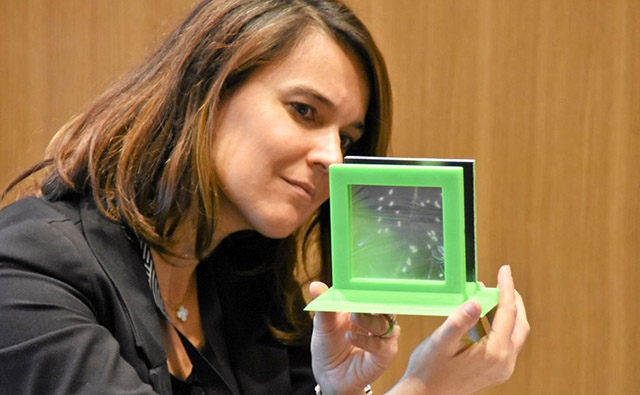Industry News, Coatings
Bio-based coatings: Sustainability 2.0

Industry News, Coatings

The transition from solvent-borne to water-borne coatings has been at the core of sustainability efforts by the coatings industry. Experts from all over Europe recently met to discuss the next step: How can the industry now transition from oil to renewable raw materials?

Innovations to see and touch: the technology forum on renewable coatings was a hands-on experience. (Picture: Jan Gesthuizen) © European Coating
But first, the meaning of sustainability had to be clarified. This was the key message from Nikolaus Raupp, Global Sustainability Manager at BASF, Ludwigshafen. Kicking off the “EC Tech Forum – Renewable Coatings” in Berlin with a highly informative introduction on the topic, he explained that simply picking any renewable raw material and switching to it was not the right approach.
It was essential, for example, to avoid getting into competition with food and feed production. There was a tendency at the moment to ignore this, and the underlying reasoning seemed to be that there was actually more than enough food in the world. Raupp strongly disagreed with this view, however, arguing that this line of argumentation was inadmissible as long as people in the world were still suffering from hunger.

Nikolaus Raupp, Global Sustainability Manager at BASF, argued that bio-based coatings should not be in competition to food and feed production. © European Coating
However, he did concede that it would not be easy to use bio-mass without entering into this competition for resources. Second-generation raw materials based on biogenic scrap and waste materials were difficult to develop, he said. BASF has developed its own approach as a way of avoiding such competition.
Its bio-mass balance method adds bio-gas and bio-naphtha to conventional natural gas and naphtha at the beginning of the production chain in its Verbund integrated production plant in Ludwigshafen. This is then processed into the usual products in the regular manner.
Both of these bio-raw materials come from harmless residues. By means of a certified balancing process, the company then adds just as much biogas and naphtha to the production process as customers eventually buy. Raupp saw this drop-in process as a bridging technology. The advantage was that the technology was already functional today and comparatively inexpensive, since the existing infrastructure could be used.

What would accelerate the usage of bio-based raw materials. © European Coating
In the long term, however, it would be important to develop completely new bio-based raw materials. In particular, were these to possess new or superior properties compared to conventional fossil materials, they would have a chance of prevailing on the market. However, he drew the line at using materials that delivered inferior properties than the status quo. Since bio-based raw materials are usually more expensive than established products, cutting back on quality was not an option. Customers would not go along with that.

What is the most promising area for a positive development of bio-based alternatives in the future? © European Coating
Costs were also a topic elsewhere. A survey among the assembled experts revealed that the majority of them expected the costs of new bio-based raw materials to be uncompetitive against fossil raw materials for another seven years at least. Patience would therefore seem in order. On the other hand, 20 % of the experts believed that competitiveness could be achieved in as little as three years’ time.
The totally new raw materials that Nikolaus Raupp had called for earlier were in widespread evidence throughout the conference. Thus, Olivia Giani from the Charles Gerhard Institute in Montpellier, France, presented new UV-curable coatings. She had opted for isosorbitol derived from starch as her source of bio-based raw material. She also demonstrated how amino acids could serve as monomers in the development of novel coatings.
DSM, too, presented new raw materials and had also chosen amino acids. Cor Koning, a Senior Science Fellow at the Dutch raw materials supplier, presented new bio-based alkyd resins. The raw materials here are fatty acids, vegetable oils and polyols such as glycerol and pentaerythritol. The company uses imides derived in situ from natural amino acids to substitute bio-based materials for monomers that have a high Tg, such as phthalic anhydride, benzoic acid and IPA.
Koning also addressed some problems. On one hand, he agreed with other speakers that renewable raw materials were not automatically sustainable. However, he noted that bio-based raw materials also offered potential for lowering our dependence on oil, with its fluctuating prices, and the often politically unstable oil-producing countries.
Numerous workshops featured a wide range of other novel bio-based raw materials and offered practical solutions for the laboratory. There were live coating interactive coating sessions and samples were passed around, but more importantly there was plenty of in-depth discussion.

Tobias Robert of Fraunhofer-Institute for wood research, spoke about bio-based UV coatings. © European Coating
The conference demonstrated that many bio-based raw materials already exist and that many approaches have been devised to develop further ones. However, a lot of staying power, plenty of persuasion and, as some participants admitted, perhaps a slightly higher oil price are needed.